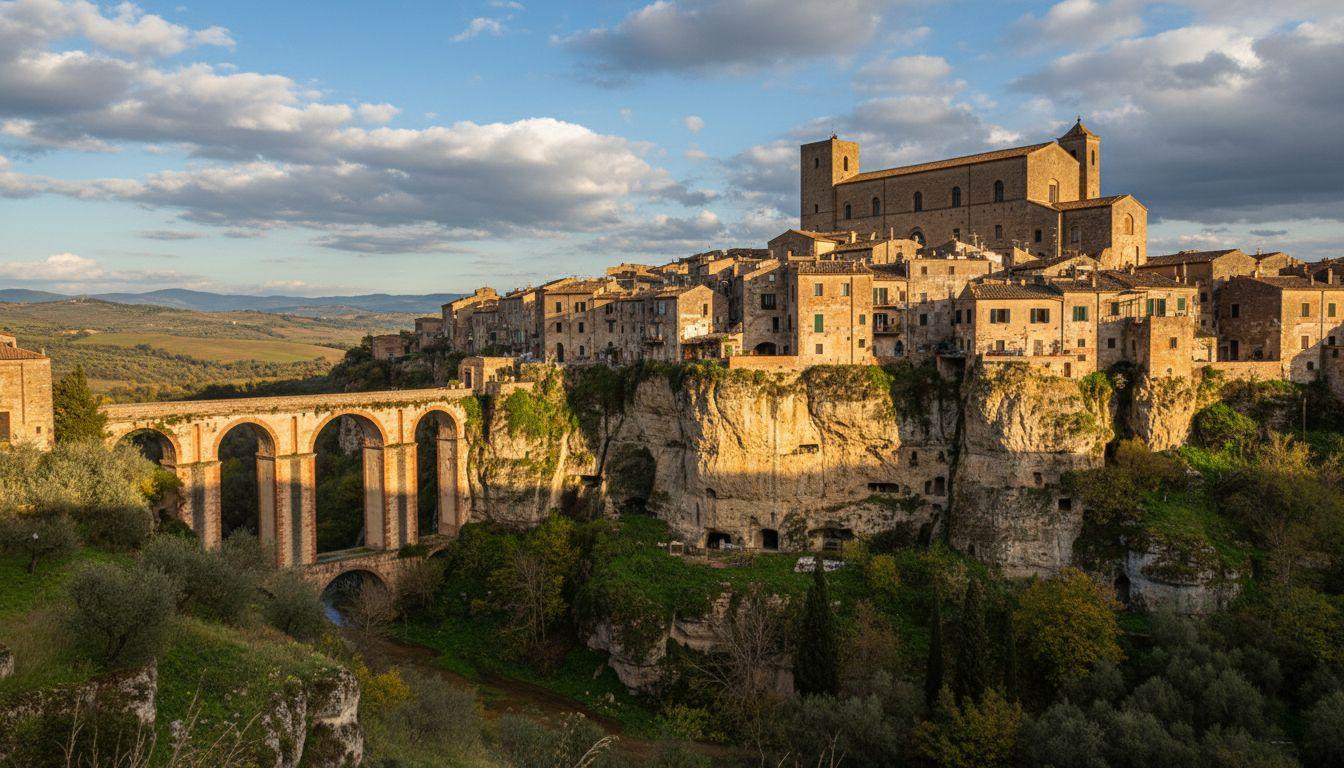November light catches San Gimignano’s 14 medieval towers as tour buses disgorge their 10,000th visitor of the day. Hotel rates hit $200. Restaurant menus display 12 languages. Meanwhile, 75 miles south, golden tuff cliffs glow above deep green valleys where 3,800 Italians live inside walls that Etruscans carved 3,000 years ago.
Better than San Gimignano’s Instagram towers, Pitigliano offers triple-heritage depth. Etruscan necropolises, medieval fortresses, and Europe’s most integrated Jewish Ghetto wait for 30% less cost and 70% fewer crowds. This volcanic village remembers what Tuscany was before the tour buses arrived.
Why San Gimignano lost its soul to selfie sticks
San Gimignano’s 14 medieval towers once guarded Tuscan trade routes. Now they guard souvenir shops. The UNESCO World Heritage site welcomes 1.8 million tourists annually (500 visitors per resident).
By 11 AM, Piazza della Cisterna becomes human gridlock. Restaurants charge $38 for mediocre pasta while authentic trattorias closed years ago. Hotel rates average $160-200 per night in peak season.
The numbers tell the story. 7,700 residents serve an economy built entirely on day-trippers who spend an average of $30 before rushing to Florence. What William Dean Howells called “the most perfectly preserved medieval town” in 1867 has become a medieval theme park. Beautiful? Absolutely. Authentic? Not since the 1980s.
Meet Pitigliano where three civilizations carved one masterpiece
Volcanic drama San Gimignano can’t match
Pitigliano rises from volcanic tuff cliffs like an extension of the earth itself. The entire town (houses, churches, fortress) was carved from the same golden stone that forms the 300-meter drop to the valley below. When sunset ignites the tuff at 5:30 PM in November, the whole village glows molten orange.
The Medicean Aqueduct (1545) spans the gorge in Renaissance arches. It still supplies water to 3,800 residents who actually live here year-round. Similar cliff villages across Southern Europe pale beside this volcanic drama.
Triple heritage no tower town can claim
San Gimignano has medieval towers. Pitigliano has layers: Etruscan necropolises (12th century BC) honeycomb the cliffs. Medieval fortress (Orsini Palace, 1293-1574) dominates the skyline. Jewish Ghetto (1598-1799) preserves synagogue, kosher bakery, mikvehs, and ritual baths carved underground.
The synagogue’s trilingual inscriptions (Hebrew, Latin, Italian) symbolize coexistence rare in medieval Europe. Local historians confirm that farmers used white or black horses to signal safety to hidden Jewish refugees during WWII. This adds human depth impossible in San Gimignano’s tourist-narrative.
What you’ll experience in Pitigliano
Empty streets that actually feel medieval
November mornings in Pitigliano begin with espresso in Piazza della Repubblica ($1.30 vs $3.80 in San Gimignano). Locals discuss yesterday’s boar hunt while tourists sleep elsewhere. Walk the medieval lanes alone.
The Jewish Ghetto’s stone passages echo only your footsteps. Local ceramics shops welcome conversation, not photo-snapping crowds. The Archaeological Museum ($7 entry) displays Etruscan artifacts found meters below your feet. Medieval monuments in similar settings charge double the price.
Tuscan cuisine without tourist prices
Trattorias serve wild boar ragu (cinghiale) for $16-20. Local Bianco di Pitigliano wine costs $13 per bottle ($38 in San Gimignano). The kosher-style bakery still makes sfratto biscuits. These honey almond cookies were created by Jews expelled from nearby towns in the 1500s.
November means porcini mushrooms, chestnuts, and new wine festivals. Meals feel like invitations, not transactions. Restaurant owners recognize repeat visitors and remember dietary preferences.
The authentic choice for discerning travelers
Pitigliano isn’t just “less crowded” than San Gimignano. It offers a fundamentally different experience where tourism enhances rather than overwhelms community life. With 62% lower tourist density, 38% lower accommodation costs, and authentic cultural experiences accessible even in November, Pitigliano represents sustainable Italian tourism.
While San Gimignano struggles with overtourism despite its UNESCO status, Pitigliano implemented smart tourism management. This preserves its Etruscan roots, Jewish heritage, and authentic Tuscan character. Similar medieval towns across Europe face the same choice.
Your questions about Pitigliano answered
How do I get there from major Italian cities?
From Rome: 2.5 hours by car (93 miles), $55-85 rental per day. From Florence: 2.5 hours (112 miles). Nearest train station is Orbetello (19 miles), then bus for $2.70. Budget-conscious medieval escapes require similar planning.
What makes the Jewish heritage so significant?
Pitigliano earned the nickname “Little Jerusalem” from the 16th century. Its Jewish community flourished despite medieval persecution elsewhere. The synagogue complex includes underground ritual baths, kosher bakeries, and trilingual inscriptions. 32 residents received “Righteous Among Nations” recognition for protecting Jewish refugees during WWII.
Is November a good time to visit compared to peak season?
November offers 70% fewer tourists, 25% lower accommodation rates, and authentic atmosphere. Average temperatures range 46-57°F with 9 rainy days per month. Most restaurants (87.5%) stay open. Local festivals include New Wine Festival (November 8-10) and Jewish Cuisine Festival (November 22-24).
San Gimignano photographs beautifully. Pitigliano photographs your soul. One fills Instagram feeds with tower selfies. The other fills November afternoons with Etruscan silence, Jewish history whispered through stone, and sunset tuff glow that no filter can capture.
